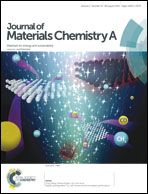Facile electrochemical synthesis of 3D nano-architectured CuO electrodes for high-performance supercapacitors†
Abstract
With a simple electrochemical process, we prepared nano-architectured CuO electrodes with a 3D hierarchically porous structure and an excellent supercapacitive performance. These nano-architectured CuO electrodes were processed through co-deposition of a Ni–Cu layer on Ni foam, selective etching of Cu from the Ni–Cu film (leaving tentacle-like nanoporous Ni), and anodic deposition of CuO nanoribbons (NRs) on the tentacle-like nanoporous Ni/Ni foam substrate. Because of its unique nano-architecture, the prepared CuO nanoribbon-on-Ni-nanoporous/Ni foam (CNRNP) electrode shows exceptional performance of energy storage relative to a conventional version of the electrode. The CNRNP electrode has also a superior kinetic performance relative to CuO nanoflake-on-Ni foam (CNFNF) and flake-like CuO (FLC) electrodes. Besides its excellent cyclic stability, an exceptionally large specific capacitance of 880 and 800 F g−1 (deducting the substrate capacitance from the total) for the CNRNP electrode is obtained at scan rates of 10 and 200 mV s−1, respectively. The excellent pseudocapacitive characteristics of CNRNP electrodes associated with the variation of the Cu oxidation state during charge and discharge cycles were elucidated with in situ X-ray absorption near-edge structure (XANES) spectra.


 Please wait while we load your content...
Please wait while we load your content...